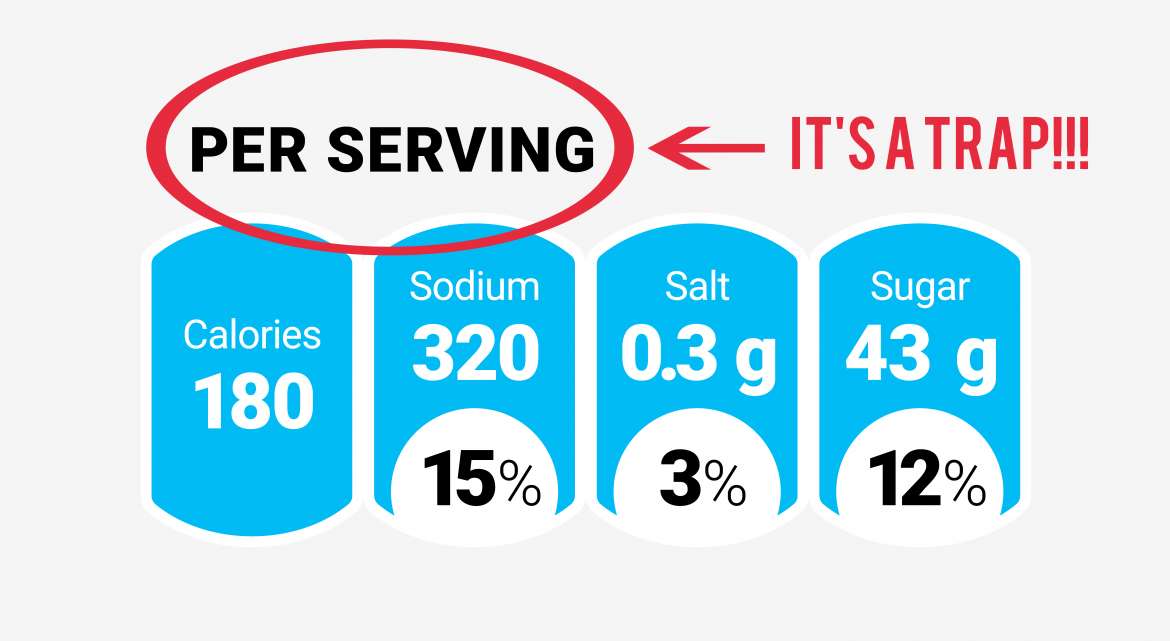Understanding food packaging and nutrition labels is key to healthy eating and weight management. Just like a sound financial plan needs to keep track of expenses and incomes, a good diet will monitor the intake and needs of calories and nutrients.
We usually get all our nutrient info from food labels, but what if I told you that those could be quite misleading?
Both the packaging and naming of foods along with their actual nutrition labels leave a lot of room for deception. In this post, I will show you how to spot false claims and what to look for instead. Together with my post on how to read a nutrition label, you will know how to find the right foods for your diet.
Let’s start with a few marketing slogans that you should be familiar with. Unfortunately, many of them only sound healthy but are ultimately meaningless:
Misleading Terms Like “Healthy” Or “Natural”
The first and best example is the term “natural”. The FDA has no legal definition of ‘natural,’ which means anyone can claim their product is natural no matter how processed or full of calories it is. That means if a food has a big sign saying “natural” on its packaging, that tells you basically nothing about what’s inside.
Other terms you should be careful with are “light” and “healthy.” While these are regulated by the FDA, it’s only in regards to fat content.
Pretty much any food that derives less than 50 percent of its calories from fat can be called “light” or “healthy” by its producer. Obviously, this says nothing about the nutritional value of a product.
For example, most artificially sweetened candy would fit this description but many nuts wouldn’t. As you can see, just like “natural” the terms “light” and “healthy” are meaningless.
There are even more examples I could go into like “gluten-free” or “cholesterol-free”. Even if they are regulated, these terms usually only mean that a food meat one specific criterion. It doesn’t say anything about the actual calorie and nutrients in the food or how it fits into your diet.
For this you should turn the package over and take a look at the nutrient label. Unfortunately, only a very small percentage of people – around 15 percent – actually look at the nutrition labels in any detail, but this is vital to your dieting success. If you don’t know what to look for check out this post.
The “Calories Per Serving” Trap
But keep in mind that nutrient labels aren’t perfect either. The biggest trap is the notion of “calories calculated per serving”. You might think that a serving is the entire package, but that is almost never the case. Food manufacturers are fairly free in how they define a serving so it’s usually a lot less than the entire package to reduce the calorie count.
For example, ramen noodles only have around 200 calories per serving, but according to one brand, a serving size is only half a package. Therefore the actual calorie value of a package would be closer to 400 calories.
My tip for you: Always compare calories on a 100 gram basis. Most foods will list the calories in 100 grams below the calories per serving anyway. If a product doesn’t, either round up to 100 gram or skip it.
You would hope that this is the only way food manufacturers try to mislead you, but there is more. Even once you control for differences in servings sizes, the actual values that are displayed on the nutrition label allow for a wide margin of error.
Calorie information can be off by 20% in either direction, so if a nutrition label says that a food contains 300 calories, you can actually get anything from 240 to 360 calories.
As frustrating as this sounds, it’s often difficult to calculate the exact caloric value of a food, especially when it’s highly processed and made of many ingredients.
In theory, the right way to determine the energy value of a food is by using a bomb calorimeter. This is a small chamber where the food is burned to heat water while measuring the temperature of the water.
The hotter the water gets, the higher the calorie count. But doing this isn’t always practical so many food companies instead add up the calories of the individual ingredients. Depending on how accurate the input data is, you get a good estimate of the actual calorie value.
One question many people have when they hear this is:
Why Even Bother Counting Calories If Food Labels Are Wrong?
Here is my take on this:
Even though nutrition labels may not be as accurate as you thought, they are still useful. You should use them to get a good estimate of the general calories of a food and to compare different options when you are uncertain about what to buy.
Another important factor is that the more ingredients a food has and the more it has been processed, the higher the likelihood of estimation errors. This means that whole foods are generally a lot less prone to such discrepancies than junk food.
So, if you follow a balanced diet that focuses on quality foods, tracking calories still makes sense and is something I recommend for most beginners.



